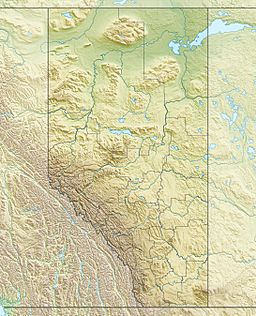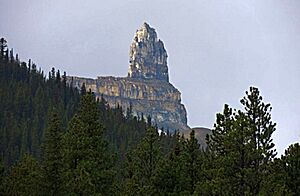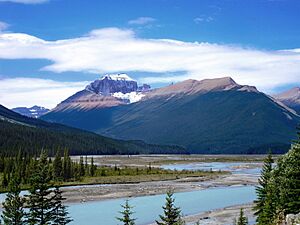Mount Saskatchewan (Alberta) facts for kids
Quick facts for kids Mount Saskatchewan |
|
|---|---|

Mt. Saskatchewan with magnified inset of the Lighthouse Tower
|
|
| Highest point | |
| Elevation | 3,342 m (10,965 ft) |
| Prominence | 1,102 m (3,615 ft) |
| Parent peak | Mount Andromeda (3450 m) |
| Listing | Mountains of Alberta |
| Geography | |
| Parent range | Columbia Icefield |
| Topo map | NTS 83C/03 |
| Climbing | |
| First ascent | 1923 by Conrad Kain, W.S. Ladd, J. Monroe Thorington |
| Easiest route | technical climb |
- For the peak by this name in Kluane National Park, see Mount Saskatchewan (Yukon).
Mount Saskatchewan is a tall mountain located in the North Saskatchewan River valley. You can find it within Banff National Park in the Canadian Rockies of Alberta, Canada.
This impressive peak stands 3,342 meters (about 10,965 feet) high. It was named in 1898 by J. Norman Collie. He chose the name because the mountain is very close to the Saskatchewan River. Some say he named it because the river's source begins right there.
Lighthouse Tower: A Unique Rock Formation
On the eastern side of Mount Saskatchewan, there's a cool rock spire called Lighthouse Tower. It's about 75 meters (246 feet) tall and stands about two kilometers from the main summit. Sometimes, people also call it "Cleopatra's Needle."
This unique tower reaches an elevation of 2,960 meters (9,711 feet). The first people to climb it were G. Boehnisch and L. Mackay in 1964.
How Mount Saskatchewan Was Formed
Like many mountains in Banff Park, Mount Saskatchewan is made of sedimentary rock. This type of rock forms from layers of sand, mud, and tiny bits of ancient sea creatures that settle at the bottom of shallow seas over millions of years.
These rock layers were laid down during the Precambrian and Jurassic periods. Later, during a time called the Laramide orogeny, huge forces pushed these rocks eastward. This caused them to fold and lift, forming the mountains we see today. On the north side of Mount Saskatchewan, there's a glacier that you can see clearly from Parker Ridge.
Climate and Weather on the Mountain
Mount Saskatchewan has a subarctic climate. This means it has very cold, snowy winters. Temperatures can drop below -20 °C (which is -4 °F), and with the wind, it can feel even colder, sometimes below -30 °C (-22 °F).
However, the summers are mild and pleasant. The weather during the summer months is usually the best time for climbing and exploring the mountain.




